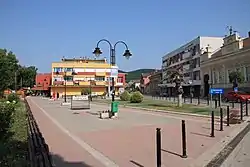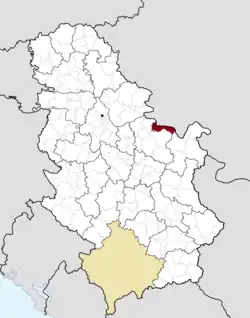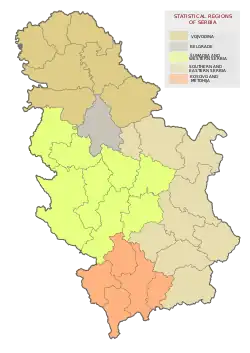Golubac
| |
|---|---|
Village and municipality | |
 Town Center | |
 Flag  Coat of arms | |
 Location of the municipality of Golubac within Serbia | |
| Coordinates: 44°39′N 21°38′E / 44.650°N 21.633°E | |
| Country | |
| Region | Southern and Eastern Serbia |
| District | Braničevo |
| Settlements | 24 |
| Government | |
| • Mayor | Nebojša Miović (SNS) |
| Area | |
| • Town | 41.74 km2 (16.12 sq mi) |
| • Municipality | 367.29 km2 (141.81 sq mi) |
| Elevation | 72 m (236 ft) |
| Population (2011 census)[2] | |
| • Town | 1,653 |
| • Town density | 40/km2 (100/sq mi) |
| • Municipality | 8,331 |
| • Municipality density | 23/km2 (59/sq mi) |
| Time zone | UTC+1 (CET) |
| • Summer (DST) | UTC+2 (CEST) |
| Postal code | 12223 |
| Area code | +381(0)12 |
| Car plates | PO |
| Climate | Cfb |
| Website | www |
Golubac (Serbian Cyrillic: Голубац, pronounced [ɡǒlubats]; Romanian: Golubăț) is a village and municipality located in the Braničevo District of eastern Serbia. Situated on the right side of the Danube river, it is bordered by Romania to the east, Veliko Gradište to the west and Kučevo to the south. The population of the village is 1,655 and the population of the municipality is 8,331. Due to many nearby archeological sites and the Đerdap national park, the village is a popular tourist, fishing and sailing destination.
Name
.jpg.webp)
In Serbian, the town is known as Golubac (Голубац), derived from golub ("pigeon" or "dove") and is therefore often translated as "the town of doves." Other names: Romanian: Golubăț (also known as Golumbacu Mare or Columbacu), Hungarian: Galambóc, German: Taubenberg and Turkish: Güvercinlik meaning "dovecote."
Historically, it was known as Columbria in Latin, a contraction of (castrum) Columbaria meaning "city of pigeons" (Latin: Columba, Greek: kòlymbos), and as a city derived from Cuppae during pre-Roman times.
History
It was a stronghold called Cuppae during Roman and Early Byzantine times (1-6th century) and turned into a city (Columbria) in 554/5 AD.[3]
Archeological sites include the remnants of one of Roman Emperor Trajan's tables near Trajan's Bridge, found along his road through the Danube's Iron Gates; and the Roman fortress Diana. Golubac fortress, 4 km downstream, is from the 14th century and also of interest. The fortress was the scene of a battle against the Turks in 1428, where the Polish knight Zawisza Czarny was captured and executed by the Turks.
Charles I of Hungary conquered the castle in 1334. In 1387 Lazar of Serbia besieged it. Becoming a Hungarian ally in 1403–04, he received large possessions, including the important Belgrade and Golubac Fortress. The Turkish occupied it for the first time in 1391, but after that, Péter Perényi recaptured it. King Sigismund of Hungary acquired Golubac by a contract in 1427, but its Serbian captain sold it to the Turks for twelve thousand golden coins. Sigismund besieged the fortress in spring 1428 in response, but the mission was a failure, the King himself was almost killed by the Turks. In 1458, Matthias Corvinus tried to recapture it, but the siege was interrupted by Hungarian internal conflicts.
From 1929 to 1941, Golubac was part of the Morava Banovina of the Kingdom of Yugoslavia.
Demographics
According to the 2011 census results, the municipality of Golubac has a population of 8,331 inhabitants.
| Year | Pop. | ±% p.a. |
|---|---|---|
| 1948 | 14,844 | — |
| 1953 | 15,166 | +0.43% |
| 1961 | 15,320 | +0.13% |
| 1971 | 14,178 | −0.77% |
| 1981 | 13,541 | −0.46% |
| 1991 | 12,513 | −0.79% |
| 2002 | 9,913 | −2.10% |
| 2011 | 8,331 | −1.91% |
| Source: [4] | ||
Ethnic groups
The ethnic composition of the municipality:[5]
| Ethnic group | Population | % |
|---|---|---|
| Serbs | 7,576 | 90.94% |
| Vlachs | 424 | 5.09% |
| Romani | 52 | 0.62% |
| Romanians | 47 | 0.56% |
| Yugoslavs | 13 | 0.16% |
| Montenegrins | 9 | 0.11% |
| Macedonians | 7 | 0.08% |
| Croats | 6 | 0.07% |
| Hungarians | 5 | 0.06% |
| Others | 192 | 2.30% |
| Total | 8,331 |
Economy
The following table gives a preview of total number of employed people per their core activity (as of 2017):[6]
| Activity | Total |
|---|---|
| Agriculture, forestry and fishing | 47 |
| Mining | 45 |
| Processing industry | 183 |
| Distribution of power, gas and water | 1 |
| Distribution of water and water waste management | 36 |
| Construction | 39 |
| Wholesale and retail, repair | 182 |
| Traffic, storage and communication | 30 |
| Hotels and restaurants | 90 |
| Media and telecommunications | 3 |
| Finance and insurance | 5 |
| Property stock and charter | - |
| Professional, scientific, innovative and technical activities | 38 |
| Administrative and other services | 39 |
| Administration and social assurance | 114 |
| Education | 116 |
| Healthcare and social work | 70 |
| Art, leisure and recreation | 25 |
| Other services | 30 |
| Total | 1,091 |
Tourism
The Iron Gate national park is noted for its natural environment and its hunting grounds, as well as its hiking trails. The village's quay along the Danube river is popular for more relaxed hiking.
Sailing
Golubac has become a well-known sailing site. The Sailing Center of the Sailing Association of Serbia, which the Serbian National Team uses for ground preparations before major sailing events, is located in Golubac. One of the events is a sailing Regatta, which is traditionally held in August. During the summer, the Center holds an Optimist Class sailing camp, where beginners can learn from the best Serbian sailors and their international guests.
See also
References
- ↑ "Municipalities of Serbia, 2006". Statistical Office of Serbia. Retrieved 2010-11-28.
- ↑ "2011 Census of Population, Households and Dwellings in the Republic of Serbia: Comparative Overview of the Number of Population in 1948, 1953, 1961, 1971, 1981, 1991, 2002 and 2011, Data by settlements" (PDF). Statistical Office of Republic Of Serbia, Belgrade. 2014. ISBN 978-86-6161-109-4. Retrieved 2014-06-27.
- ↑ Notitia Dignitatum, the Synekdêmos and Prokopios’s Buildings IV.v.-vii, x
- ↑ "2011 Census of Population, Households and Dwellings in the Republic of Serbia" (PDF). stat.gov.rs. Statistical Office of the Republic of Serbia. Archived from the original (PDF) on 14 July 2014. Retrieved 11 January 2017.
- ↑ "ETHNICITY Data by municipalities and cities" (PDF). stat.gov.rs. Statistical Office of the Republic of Serbia. Retrieved 20 February 2018.
- ↑ "ОПШТИНЕ И РЕГИОНИ У РЕПУБЛИЦИ СРБИЈИ, 2018" (PDF). stat.gov.rs (in Serbian). Statistical Office of the Republic of Serbia. Retrieved 16 March 2019.

